Constant Click “Allow” to receive notifications pop ups, especially if those pop ups occur automatically and unexpectedly, can be indicative of adware (also known as ‘ad-supported’ software) installed on your PC.
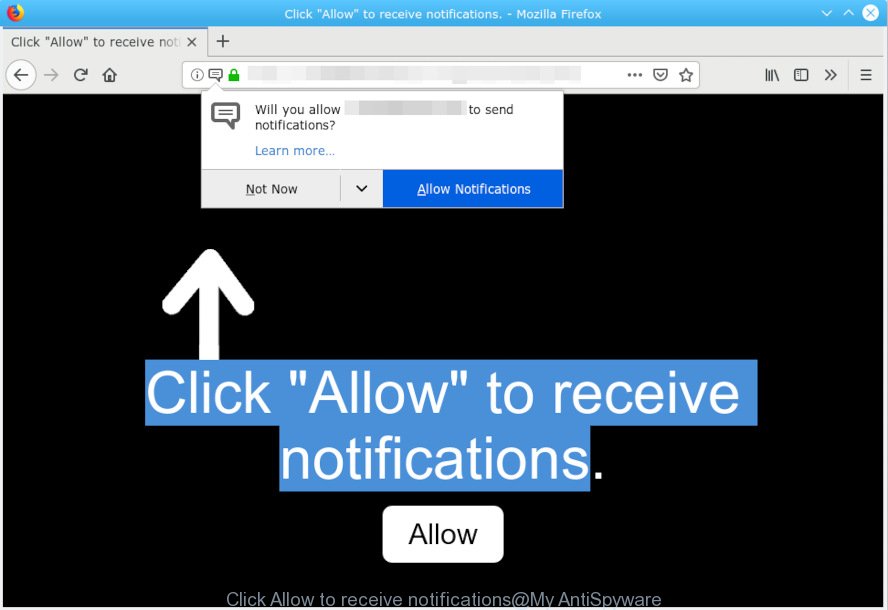
Click “Allow” to receive notifications POP UP
The Dangers of Adware. Adware is a type of potentially unwanted apps whose motive is to make money for its creator. It have various methods of earning by displaying the advertisements forcibly to its victims. Adware can open popup windows, show unsolicited advertisements, modify the victim’s web-browser settings, or reroute the victim’s browser to unwanted web-pages. Aside from causing unwanted ads and web-browser redirects, it also can slow down the machine.
The worst is, adware can be used to gather user information such as what web-sites you are opening, what you are looking for the Web and so on. This privacy info, afterwards, may be sold to third parties.
Adware actively distributed with free software (with the installer of these applications). Therefore, it’s very important, when installing an unknown application even downloaded from well-known website, read the Terms of use and the Software license, as well as to choose the Manual, Advanced or Custom installation option. In this method, you can disable the setup of unnecessary web browser add-ons and applications and protect your PC from adware. Do not repeat the mistakes of most users when installing unknown programs, simply press the Next button, and don’t read any information which the free software open them during its installation.
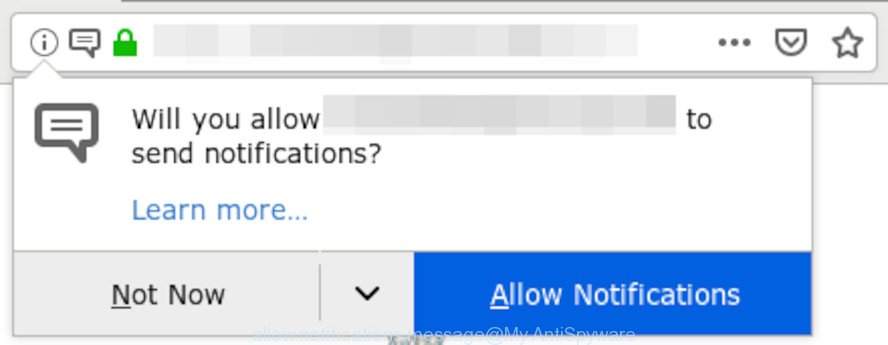
According to IT security experts, Click “Allow” to receive notifications pop-up is a webpage that uses the browser notification feature to trick you and other unsuspecting victims into subscribing to push notifications. It will show a ‘Click Allow to continue’ message, asking you to subscribe to notifications. If you click the ‘Allow’, then you will start seeing unwanted adverts in form of popups on your desktop. The browser notification spam will promote ‘free’ online games, prize & lottery scams, suspicious web-browser add-ons, adult web-sites, and adware software bundles as displayed in the following example.

If you’re receiving browser notification spam, you can remove subscriptions by going into your browser’s settings or complete the “Click Allow to receive notifications” removal guide below.
Threat Summary
| Name | “Click Allow to receive notifications” |
| Type | adware, PUP (potentially unwanted program), popups, pop up ads, pop-up virus |
| Symptoms |
|
| Removal | “Click Allow to receive notifications” removal guide |
If you noticed any of the symptoms mentioned above, we recommend you to complete step-by-step tutorial below to remove the adware and remove “Click Allow to receive notifications” pop ups from your web browser.
How to remove “Click Allow to receive notifications” pop-ups, ads, notifications (Removal tutorial)
Even if you have the up-to-date classic antivirus installed, and you’ve checked your system for malware and removed anything found, you need to do the guide below. The “Click Allow to receive notifications” popups removal is not simple as installing another antivirus. Classic antivirus applications are not designed to run together and will conflict with each other, or possibly crash Microsoft Windows. Instead we recommend complete the manual steps below after that run Zemana Free, MalwareBytes Anti Malware (MBAM) or HitmanPro, which are free applications dedicated to scan for and remove adware software that cause unwanted “Click Allow to receive notifications” pop up. Use these tools to ensure the adware is removed.
To remove “Click Allow to receive notifications” pop ups, complete the steps below:
- Delete “Click Allow to receive notifications” popups without any tools
- How to automatically remove “Click Allow to receive notifications” popups
- How to stop “Click Allow to receive notifications” popups
- To sum up
Delete “Click Allow to receive notifications” popups without any tools
The steps will help you remove “Click Allow to receive notifications” popups. These removal steps work for the IE, Microsoft Edge, Mozilla Firefox and Chrome, as well as every version of operating system.
Uninstall dubious applications using Microsoft Windows Control Panel
We advise that you begin the PC cleaning procedure by checking the list of installed software and delete all unknown or questionable applications. This is a very important step, as mentioned above, very often the harmful programs such as adware and hijacker infections may be bundled with freeware. Remove the unwanted software can get rid of the undesired advertisements or web-browser redirect.
Press Windows button ![]() , then press Search
, then press Search ![]() . Type “Control panel”and press Enter. If you using Windows XP or Windows 7, then click “Start” and select “Control Panel”. It will open the Windows Control Panel as shown on the screen below.
. Type “Control panel”and press Enter. If you using Windows XP or Windows 7, then click “Start” and select “Control Panel”. It will open the Windows Control Panel as shown on the screen below.

Further, press “Uninstall a program” ![]()
It will open a list of all apps installed on your PC system. Scroll through the all list, and remove any suspicious and unknown apps.
Get rid of “Click Allow to receive notifications” pop ups from Internet Explorer
By resetting Microsoft Internet Explorer web-browser you return your internet browser settings to its default state. This is good initial when troubleshooting problems that might have been caused by adware software responsible for “Click Allow to receive notifications” pop-ups.
First, open the Internet Explorer, click ![]() ) button. Next, click “Internet Options” as displayed in the following example.
) button. Next, click “Internet Options” as displayed in the following example.

In the “Internet Options” screen select the Advanced tab. Next, click Reset button. The IE will show the Reset Internet Explorer settings dialog box. Select the “Delete personal settings” check box and click Reset button.

You will now need to restart your PC system for the changes to take effect. It will remove adware responsible for “Click Allow to receive notifications” pop ups, disable malicious and ad-supported browser’s extensions and restore the Internet Explorer’s settings such as search provider by default, new tab page and home page to default state.
Remove “Click Allow to receive notifications” pop ups from Mozilla Firefox
If the Firefox settings have been replaced by the adware software, then resetting it to the default state can help. However, your themes, bookmarks, history, passwords, and web form auto-fill information will not be deleted.
Run the Firefox and click the menu button (it looks like three stacked lines) at the top right of the web-browser screen. Next, click the question-mark icon at the bottom of the drop-down menu. It will display the slide-out menu.

Select the “Troubleshooting information”. If you’re unable to access the Help menu, then type “about:support” in your address bar and press Enter. It bring up the “Troubleshooting Information” page like below.

Click the “Refresh Firefox” button at the top right of the Troubleshooting Information page. Select “Refresh Firefox” in the confirmation dialog box. The Mozilla Firefox will start a process to fix your problems that caused by adware. When, it’s complete, click the “Finish” button.
Remove “Click Allow to receive notifications” pop-ups from Chrome
Use the Reset browser tool of the Chrome to reset all its settings to original defaults. This is a very useful tool to use, in the case of internet browser redirects to unwanted web-sites like the “Click Allow to receive notifications” page.
Open the Chrome menu by clicking on the button in the form of three horizontal dotes (![]() ). It will display the drop-down menu. Select More Tools, then click Extensions.
). It will display the drop-down menu. Select More Tools, then click Extensions.
Carefully browse through the list of installed plugins. If the list has the extension labeled with “Installed by enterprise policy” or “Installed by your administrator”, then complete the following guidance: Remove Google Chrome extensions installed by enterprise policy otherwise, just go to the step below.
Open the Chrome main menu again, click to “Settings” option.

Scroll down to the bottom of the page and click on the “Advanced” link. Now scroll down until the Reset settings section is visible, as displayed on the screen below and press the “Reset settings to their original defaults” button.

Confirm your action, click the “Reset” button.
How to automatically remove “Click Allow to receive notifications” popups
There are not many good free anti malware applications with high detection ratio. The effectiveness of malware removal tools depends on various factors, mostly on how often their virus/malware signatures DB are updated in order to effectively detect modern malware, adware, browser hijacker infections and other potentially unwanted software. We advise to use several applications, not just one. These programs that listed below will help you get rid of all components of the adware software from your disk and Windows registry and thereby delete “Click Allow to receive notifications” pop-ups.
Remove “Click Allow to receive notifications” popup with Zemana Free
You can download and use the Zemana AntiMalware (ZAM) for free. This anti malware tool will scan all the MS Windows registry keys and files in your PC along with the system settings and web browser extensions. If it finds any malware, adware software or malicious add-on that is responsible for redirecting your web browser to the “Click Allow to receive notifications” webpage then the Zemana Free will remove them from your computer completely.

- Installing the Zemana is simple. First you will need to download Zemana Anti Malware (ZAM) on your computer by clicking on the link below.
Zemana AntiMalware
164813 downloads
Author: Zemana Ltd
Category: Security tools
Update: July 16, 2019
- After the downloading process is done, close all software and windows on your personal computer. Open a file location. Double-click on the icon that’s named Zemana.AntiMalware.Setup.
- Further, click Next button and follow the prompts.
- Once installation is finished, click the “Scan” button to find adware related to the “Click Allow to receive notifications” pop-ups. A scan can take anywhere from 10 to 30 minutes, depending on the number of files on your computer and the speed of your computer. When a threat is found, the count of the security threats will change accordingly.
- Once the system scan is complete, Zemana Free will show a screen that contains a list of malicious software that has been detected. Once you have selected what you wish to remove from your system press “Next”. After the clean-up is finished, you can be prompted to restart your system.
Remove “Click Allow to receive notifications” pop-up from web browsers with Hitman Pro
The HitmanPro tool is free (30 day trial) and easy to use. It can scan and get rid of malware, PUPs and adware in Firefox, Chrome, Microsoft Edge and Internet Explorer web-browsers and thereby remove all undesired “Click Allow to receive notifications” popups. HitmanPro is powerful enough to find and remove malicious registry entries and files that are hidden on the computer.
Click the link below to download the latest version of Hitman Pro for Windows. Save it to your Desktop.
When the download is done, open the directory in which you saved it and double-click the Hitman Pro icon. It will run the Hitman Pro utility. If the User Account Control prompt will ask you want to run the application, click Yes button to continue.

Next, click “Next” . Hitman Pro program will scan through the whole system for the adware software which cause intrusive “Click Allow to receive notifications” pop up. A scan may take anywhere from 10 to 30 minutes, depending on the count of files on your machine and the speed of your PC. During the scan HitmanPro will scan for threats present on your computer.
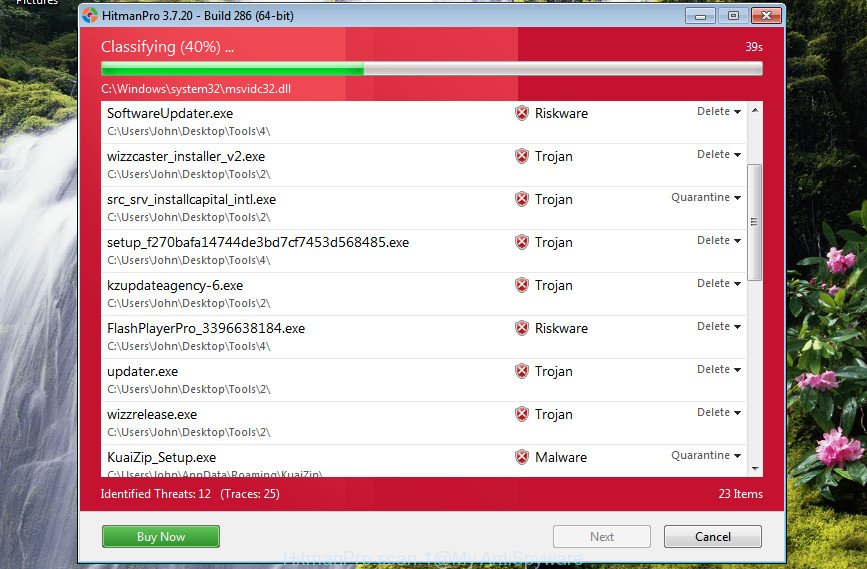
After the scanning is finished, the results are displayed in the scan report as shown below.
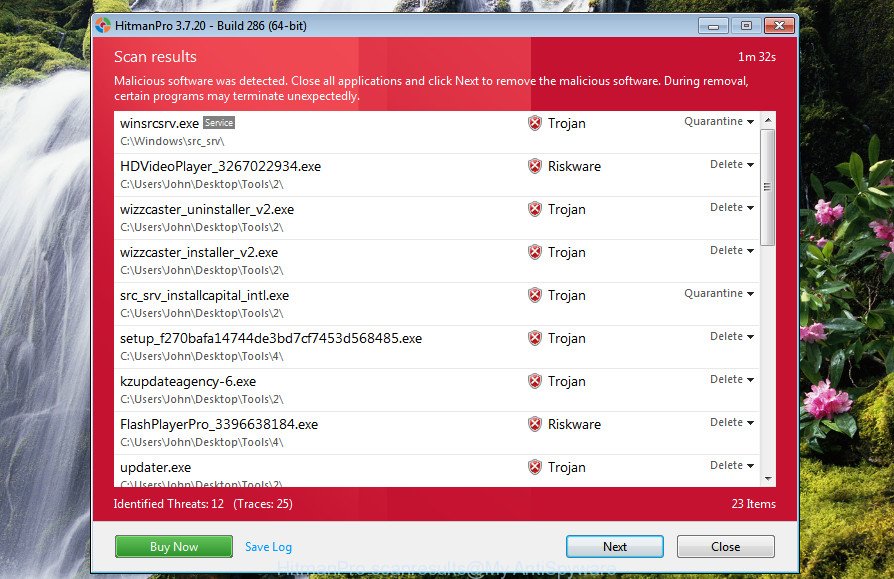
Make sure all threats have ‘checkmark’ and click “Next” button. It will show a prompt, click the “Activate free license” button. The Hitman Pro will get rid of adware that cause popups and add items to the Quarantine. After finished, the utility may ask you to restart your system.
Automatically get rid of “Click Allow to receive notifications” pop up with MalwareBytes Free
If you are having issues with “Click Allow to receive notifications” popup removal, then check out MalwareBytes Anti Malware. This is a tool that can help clean up your computer and improve your speeds for free. Find out more below.
Installing the MalwareBytes Free is simple. First you’ll need to download MalwareBytes Free on your system from the following link.
327071 downloads
Author: Malwarebytes
Category: Security tools
Update: April 15, 2020
When the downloading process is finished, close all programs and windows on your PC system. Open a directory in which you saved it. Double-click on the icon that’s named mb3-setup as shown on the image below.
![]()
When the setup begins, you will see the “Setup wizard” that will help you install Malwarebytes on your PC system.
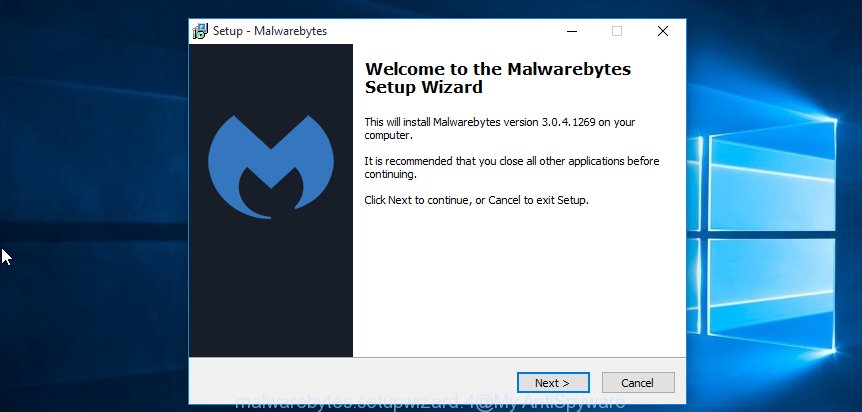
Once installation is complete, you will see window as shown on the image below.
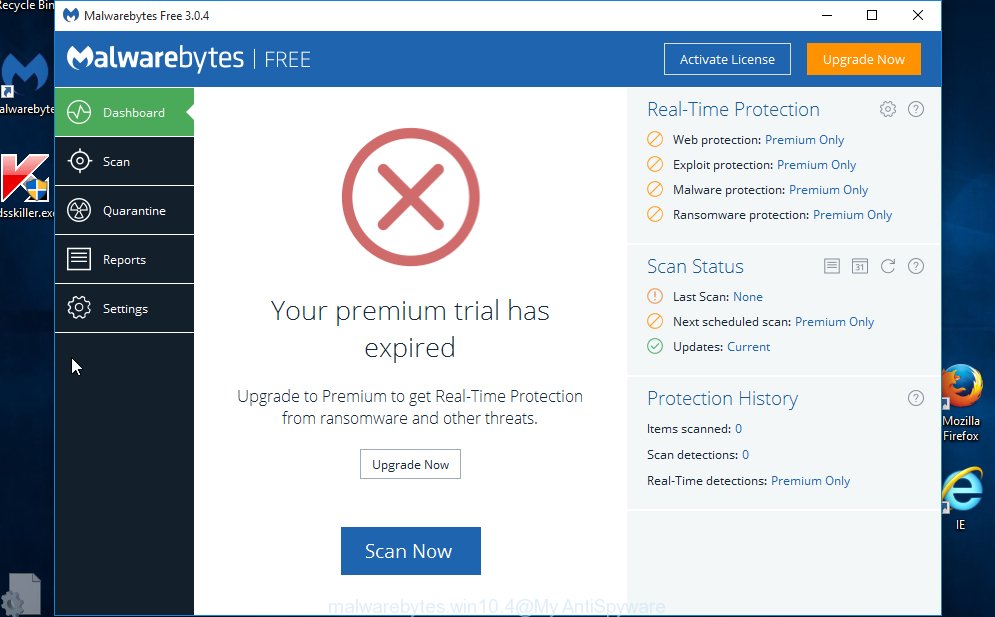
Now click the “Scan Now” button . MalwareBytes tool will start scanning the whole computer to find out adware related to the “Click Allow to receive notifications” pop up. This task may take quite a while, so please be patient.
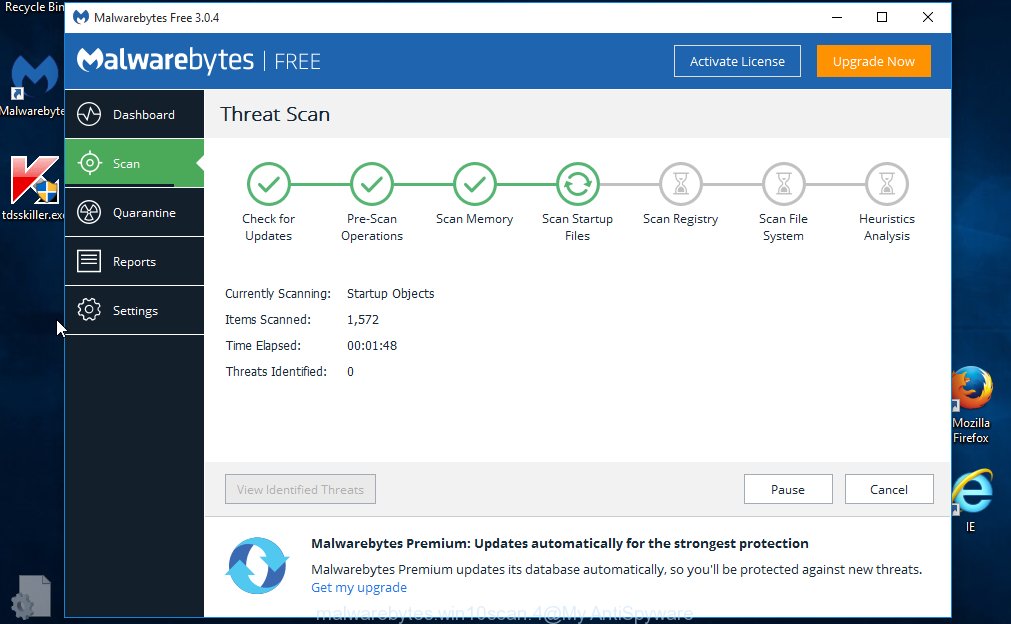
When the scan is complete, a list of all threats found is created. Review the scan results and then click “Quarantine Selected” button.
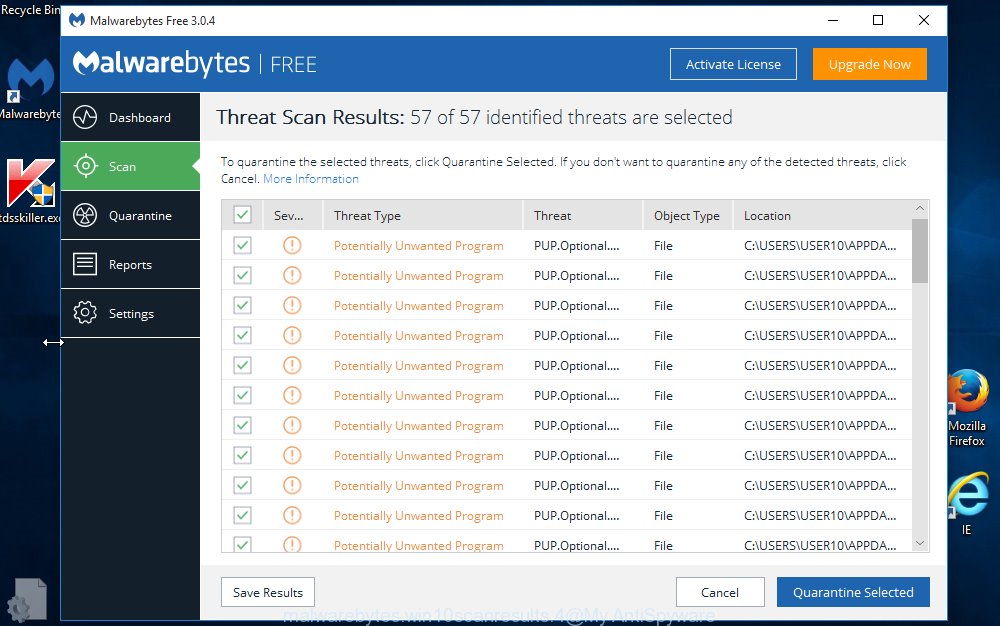
The Malwarebytes will now begin to delete adware responsible for “Click Allow to receive notifications” pop-ups. When finished, you may be prompted to reboot your PC.

The following video explains steps on how to get rid of hijacker infection, adware and other malware with MalwareBytes.
How to stop “Click Allow to receive notifications” popups
If you surf the Internet, you can’t avoid malvertising. But you can protect your web browser against it. Download and run an ad-blocker application. AdGuard is an ad-blocking which can filter out a huge number of of the malicious advertising, blocking dynamic scripts from loading malicious content.
Installing the AdGuard is simple. First you’ll need to download AdGuard on your MS Windows Desktop from the link below.
26843 downloads
Version: 6.4
Author: © Adguard
Category: Security tools
Update: November 15, 2018
After downloading it, double-click the downloaded file to launch it. The “Setup Wizard” window will show up on the computer screen as shown below.

Follow the prompts. AdGuard will then be installed and an icon will be placed on your desktop. A window will show up asking you to confirm that you want to see a quick guide as displayed on the image below.

Click “Skip” button to close the window and use the default settings, or press “Get Started” to see an quick guide that will help you get to know AdGuard better.
Each time, when you start your computer, AdGuard will run automatically and stop undesired ads, block “Click Allow to receive notifications” pop-ups, as well as other malicious or misleading web sites. For an overview of all the features of the application, or to change its settings you can simply double-click on the AdGuard icon, that may be found on your desktop.
To sum up
Now your system should be free of the adware that causes “Click Allow to receive notifications” pop-up. We suggest that you keep AdGuard (to help you block unwanted pop-up and intrusive malicious web-pages) and Zemana (to periodically scan your PC system for new malicious software, browser hijacker infections and adware). Make sure that you have all the Critical Updates recommended for Microsoft Windows OS. Without regular updates you WILL NOT be protected when new hijackers, malicious programs and adware are released.
If you are still having problems while trying to remove “Click Allow to receive notifications” pop-up from your web browser, then ask for help here.


















